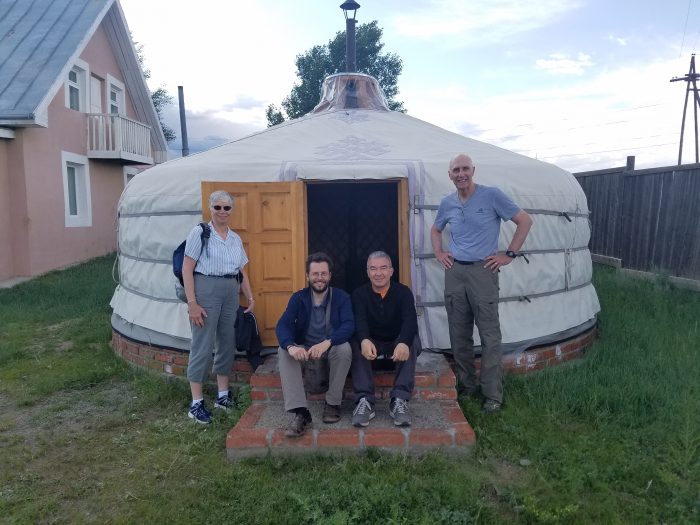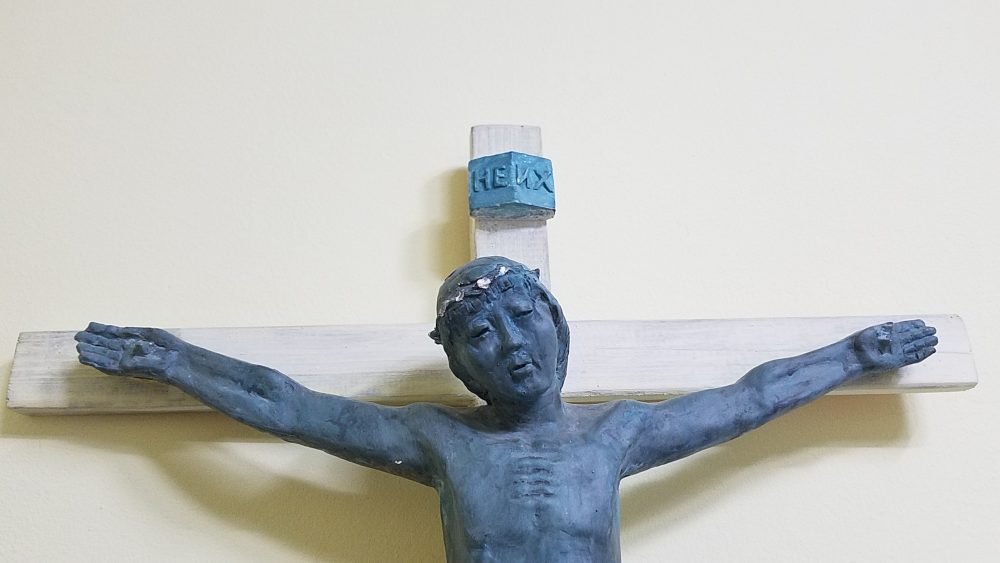Our team reached Ulaan Bataar on June 27, 2019. It took us only half a day. What a difference from the Middle Age travelers! It took them months, when they were lucky, from Europe to get to Mongolia. Yet, we too had reached the other side of the world. Twelve hours difference from New York, Montreal and Toronto. We were exactly on the other side of our planet!

We are welcomed at the airport by Fr. Giorgio Marengo, the Pastor at the Mission we are headed to, and by our local guide who offers us a bowl of horse milk, held over a blue ribbon. Blue is the color of the sky, the home of the Spirit, we are told, source of life, and of all of us when we leave earth. Earth and sky are the primary elements; and we, the humans, the animals, the trees, are within them. Both are boundless; green hills rolls beyond our view, and the vault above has an immensity that is unique.

The first perception is one of vastness, freedom, connectedness with nature below and above. The grass has an aromatic fragrance, beautiful flowers are scattered in it like stars, the wind carries the clouds like sheep and flaps our clothes while ruffling the girls’ long hair.

As the Middle Age travelers were surprised by many unexpected things when they reached Mongolia, so are we. First of all we discover that the local names are so difficult for us to learn that our tour operator, our guide and our driver have adopted other ones, …easier for us westerners to remember, and above all to pronounce! Imagine: it took us three days just to learn how to say “thank you” in Mongolian!


By the way, our names are: Denis, Carole, Barbara and Paolo (myself). We were sent by St. Augustine of Canterbury parish in Kendall Park, NJ, in order to visit the Mission of Arvaiheer with which our Parish has twinned.
Arvaiheer is a town of thirty thousand inhabitants that lies about 500 km south-west of Ulaan Bataar. It is the first mission of the Consolata Missionaries in Mongolia. However, before being sent there, the “new comers” spend around three years in the capital to learn Mongolian and get acquainted with the local customs and traditions – as well as to adapt to the local climate. Summers are hot, but winters are bitterly cold. In Ulaan Bataar, three Fathers and four Sisters occupy an apartment each, on the third and fourth floor of a popular building within the city. They invited us for dinner on the second evening of our stay; and, although it had been somehow adventurous for us to find them, since the roads have no names and the houses no numbers, we ended up having an enjoyable meal with home made pizza and …local beer (called: Chinggis)!

Before reaching Arvaiheer, we took the opportunity to visit some historical and natural resources of the country. We are taken aback by the sites: horses grazing in the steppe, “oreo” yaks, huge herds of goats and sheep, shepherds on their horses holding their lasso, white gers on the grass resembling sails in the sea. Our guide, “T S” (these are the initials of his unpronounceable name), leads us to see some outstanding Buddhist temples and introduces us to the Shamanic spirituality.

He knows both traditions since is father was Buddhist, while his mother was Shamanic. He also had the opportunity to do some research in the USA on the cultural similarities between the Mongolian people and the Native Americans. He found many! He is also quite interested in Christianity and keeps asking us questions about the tenets of our religion that he finds fascinating or difficult to grasp. He, now in his early 50s, was brought up in the years when Mongolia was under the influence of the Soviet Union; unlike the other guide we had in the following days, “B”, who is about 20 years old and has had no experience of the Marxist regime. “B” is completely uninterested in any religion what so ever. To our astonishment, he also reveals to us that his mother is Catholic, but he does not know anything more about “her religion”!

Our perception of Mongolian Buddhism is two-sided. The scary statues we see at the entrance of the temples do not inspire us in the least, in spite of “T S” explanation that they are “dreadful” because they are meant to frighten the evil spirits out from the temple visitors. Different is the impression we have when Fr. Giorgio introduces us to a monastery abbot he knows. Erdene Zuu Monastery is one of the most famous in the country. It is built on the very site of the ancient Mongolian capital: Karakorum. The abbot, who has accepted with Fr. Giorgio to take part in sessions of inter-religious dialogue that are held in different Asian countries, welcomes us and takes time to answer to our questions. In the nearby town of Kharkhorin, our missionaries have built a house in view of making it a center of inter-religious dialogue. It is a dream they look forward to its accomplishment at the soonest!

Our stay in Arvaiheer is great. The missionaries house is made up of three sections: one for the Fathers, one for the Sisters, and the third for guests. Fathers and Sisters make one community, and take turns to lead the common prayers and to prepare the meals. On the first day, Father Dido takes us for a tour of the mission. In the courtyard are three gers: one is the church, the other a classroom, while the third is a “playground”. All have their heavy iron stove in the middle. The layout of the church is very interesting: outside, at the entrance, stands a colorful cross; the center is occupied by the altar, the baptismal font and the stove. The faithful sit around. The baptismal font is made of a local stone (found by the Christians), into which a cross is hewn: it holds the rope that keeps the tent from being carried away by the winds.

The Sunday Eucharist is attended by about twenty people. There is an elderly man who is not Christian, three young men who have joined the Church recently, about ten women and some children. The community knows Christian hymns by heart and sings them nicely while the book is taken to the altar wrapped in precious cloth. Denis, our Deacon, gives the homily. Fr. Giorgio translates it into Mongolian.

We sense the pride of these faithful to belong to a family that includes peoples from all over the world. We are given gifts to take back home and then a picture is taken of us all.

Mass here is always followed by a cup of tea (salted). One of the ladies bakes bread: it is much appreciated and …really tasty!

People ask Denis why he has a wife – his wife, Carole, accompanied us – since they were told that Catholic ministers do not marry; so Fr. Giorgio has to explain that in the Church there are different ordained ministries: some, like priests, who do not marry; and others, like deacons, who can be married people. When we asked them why they had become Christian, we are moved by their answers: they have found a religion and a community of love, forgiveness, closeness to the needy, open to the whole world. They had to face opposition from their family and friends, and often their scorn. But found peace.

Ulaan Bataar welcomes us for our last three or four days in Mongolia. Soviet-era buildings, museums within surviving monasteries, and a vibrant conjunction of traditional and 21st-century lifestyles typify this city. Roads congested with traffic and Karaoke bars all over. Quite unexpected. Fr. Giorgio tells us that when he arrived, 16 years ago, many things he was used to were practically not to be found; today in the shops one can find anything: from Argentinian wine to the latest cellphone!



The traditional yearly festival, the Nadaam, takes place while we are here. We go to watch the horse riding. The local people seem to be born on horseback. Children ride them at full speed. They are in their element! The whole city drive to the race. Dust everywhere. People embrace the winner (the horse, I mean, dripping with sweat) to get its victorious strength.

My last supper in Mongolia is with our community in Ulaan Bataar. It is a joyful family meal. Fr. Mate makes chapati, and the others prepare the meat bought at a local butchery. We eat everything.

I leave with their blessing. I have shared in their spirit. They witness to their (our) faith in a demanding place: people need to find in them a reason to appreciate why they have come to Mongolia.
Fr. Paolo Fedrigoni, IMC
North Brunswick, August 30, 2019.

